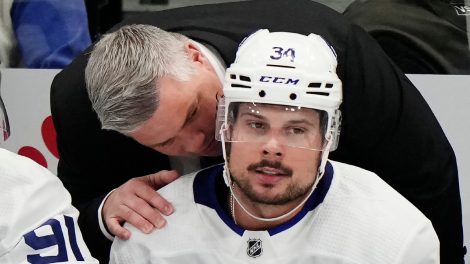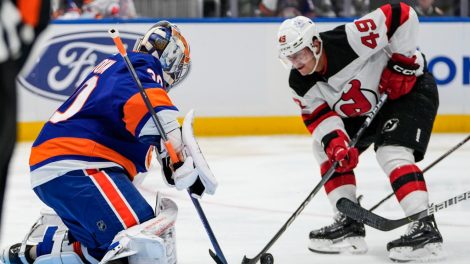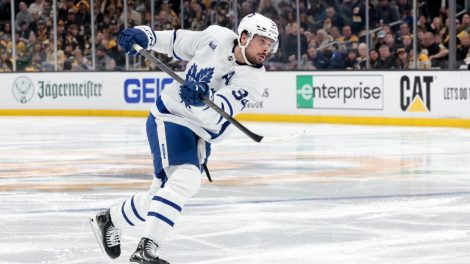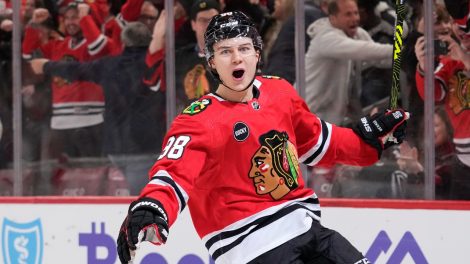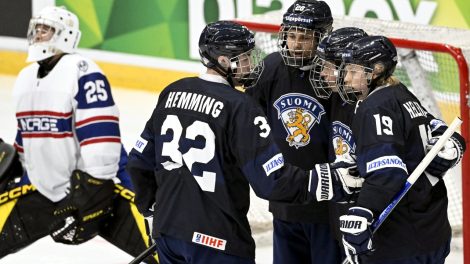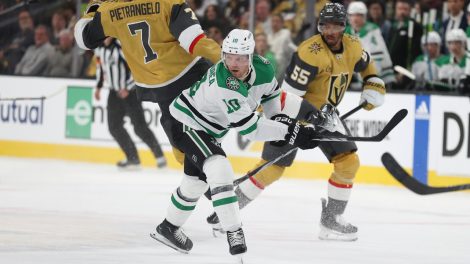When I was asked by Wendel Clark’s publicist to meet him at a Second Cup in Toronto to talk about his book, I wondered why he would agree to being so out in the open.
Then again, he had just put his life on paper in Bleeding Blue, written with broadcaster Jim Lang. And if anyone knows how to hide in plain sight, it’s a Leafs legend whose bread is still buttered by blue and white nostalgia.
But the challenge remained: how does one get Wendel to open up about his life, now on record? How would one approach the subject of Clark’s wild career without treading over the road most traveled? How does one pull words out of the mouth of a typically brief and plain-speaking interviewee from Kelvington, Saskatchewan?
As it turned out, the Second Cup we met at was both in plain sight of the Air Canada Centre and hidden beneath a highway — one that I’d passed many times during my life in Toronto and had yet to register at all in my mind. On top of that, it was the same coffee house Clark and Lang met at for a dozen or so chats about his life in hockey.
Clark’s book, which spans his childhood on a farm through dorm-room pillow fights in junior, being drafted as a defenceman, the highs and injurious lows with the Maple Leafs, and the untold stories of his time as a journeyman, is maybe the first time the bruising forward has thought this much about a career that he said came with no Plan B.

The first thing that was apparent was his tendency to talk from a second-person point of view, perhaps a product of months of self-reflection.
“You don’t think as much about yourself than you do [when you’re writing a] book but obviously you have to because Jim would be asking you questions and he would be jogging memories from the past,” Clark said with coffee in hand. “You may not remember [much] the first time and then you meet again [and the memory is clearer.]
“Because you’re playing, you’re not like a fan who watches all the exciting moments for players, whereas a player is playing and you have to forget about the game because you’re on to the next one. You’re not seeing it through the eyes of a fan.”
With Wendel in a somewhat reflective mood, I took some quick wrist shots with the former Leafs captain.
I’m trying to imagine Wendel Clark in a pillow fight. You said in the book that Russ Courtnall once counted 20 Notre Dame students in a row that you knocked over with a pillow. Were you one of the guys that would put a textbook inside the case for added weight?
No, no, mine was good. A solid feather one. Going back to that stuff in Notre Dame [it’s clear] we were all normal, average guys and maybe that shows a human side to guys that played at the highest level.
We know John Candy was a big Toronto sports fan? How did you cross paths with him?
We interacted around the game and I knew his mom had season tickets at the corner of Maple Leaf Gardens and that he was a fan of everything Toronto. My first year, he was one of the speakers at our rookie banquet 10 games in. I think we were 0-10 and he was carving us.
Some people may know that you grew up a defenceman but when did you make the switch?
I played defence my whole life but played defence and forward at world juniors in my draft year. When I came back to Saskatoon after world juniors, I played defence for the rest of the year. I was drafted as a defenceman-maybe-forward, and when I got to [Leafs] training camp, that’s when I found out I was a forward.
I grew up on defence because that’s where you got more ice time. Usually, teams would put their better players on defence because you would more often have the puck.
Your difficulty with staying healthy as a player has been well documented. Why did you choose for it to be a major theme in your book?
It’s the way I played — a physical style — and if you’re going to make a career out of it, no matter what size you are, it gets you in the end. You’re abusing your body as a way to get ahead and there’s a lot of good and bad that comes with that. You never blame somebody else, you look after yourself. When I teach kids I tell them to look after themselves on the ice, don’t wait for somebody else to look after you. You decide, because there are many different ways to get the job done.
With Cliff Fletcher, Pat Burns, how the organization was changing [in 1992-93], and the emergence of the Leafs as a good team, I stopped trying to do everything [every shift].
You talked about how early in your career, the Leafs didn’t have enough in terms of an in-house trainer who could help with your rehab. And everyone now knows the name Chris Broadhurst, but did you get him the job in Toronto in the first place?
Well, not directly or indirectly. The Toronto Maple Leafs needed a better in-house guy and he became that guy. He was the main reason I played as long as I did and he was at the forefront of changing how players got looked after in Toronto.
You spend [most of] your time with the training and medical staff. They’re the first guys you see in the morning and they’re the last guys you see going out. When we get to the hotel, they’re unpacking equipment. Players have the utmost respect for them.
How did your sticks differ depending on whether you were having a good day with your injured back or a bad day?
Depending on the curve that I had on a stick, it helped you shoot the puck harder. But if everything was totally healthy, I could go back to my standard pattern. I would tweak the pattern if I wanted the puck to jump a little more with less effort.
Why would you give yourself an extra large tape knob?
Those were in my early fighting days. If I had a fight on a Friday night and hand was too sore on Saturday, I would put a bigger knob on so I didn’t have to close it as much.
You mentioned in the book that fighting was at times thrilling for you. How so?
I played the same way in junior as I played in pro. Nobody forced me to do it and it was something I had fun doing. It was a part of the game when I played and I thought it was part of how I was able to play better.
You are so revered in Toronto and yet the Leafs were not able to win a Stanley Cup during your time. How do you define success in a Leafs jersey?
The Stanley Cup is the pinnacle but only one team gets it. But what really brings the fans and the city and the team together, if you’ve watched the Jays in recent times, is playoffs. Maybe you don’t go all the way but the fever of being a part of it, that’s the fun part.
[The parade after the ’93 playoff run] was more of an ownership or city thing that they wanted to do but we as a team were kind of surprised because we hadn’t won nothing. We lost.
Finally, and most crucially, what was the worst thing about the New York Islanders’ fisherman logo?
The logo was so big, we had to break the sweaters in when we wore them — we couldn’t move our arms.
***
And with that, Clark and I shook hands as he mentioned he was off to put winter tires on his daughter’s car for her trip back to university. I congratulated him on his recent 50th birthday to which he replied, “Yeah, I’m old now.”
Hardly old, but old enough to finally look back in time.

